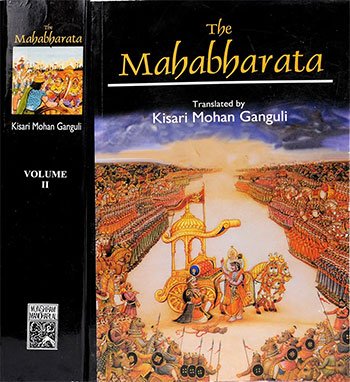Section CIX - Battle between Bhishma and Sikhandin: Epic confrontation in the Kurukshetra War
Book index: Mahabharata (English)
This page contains a summary of the Mahabharata Section CIX including examples of moral lessons in daily life. The Maha-Bharata is one of the largest epics ever written containing roughly 100,000 Sanskrit verses. It deals with the legendary history of ancient India and contains a large number of interwoven tales.
Short summary of the chapter:
The Pandavas, led by Sikhandin, formed a powerful army and marched towards the Kaurava host, with Bhishma leading the defense. Bhishma, filled with rage at seeing his army being slaughtered, unleashed a fierce attack on the Pandavas, causing great destruction. In the midst of the battle, Sikhandin confronted Bhishma, determined to fight and defeat him despite Bhishma's reluctance to fight back. Arjuna supported Sikhandin, urging him to face Bhishma with courage and determination, promising to protect him from other enemies on the battlefield.
Sikhandin, guided by Arjuna's encouragement, bravely engaged Bhishma in combat and pierced him with multiple arrows, challenging him to a decisive battle. Despite Bhishma's formidable skills and reputation as an undefeatable warrior, Sikhandin remained steadfast in his resolve to defeat him. Arjuna stood by Sikhandin's side, ready to protect him from any other threats on the battlefield and ensure that Sikhandin had the opportunity to face Bhishma directly.
Bhishma, recognizing Sikhandin as the one destined to be his downfall, faced him in battle, acknowledging his prowess and determination. The two warriors clashed fiercely, with Sikhandin unleashing all his skill and strength to defeat the legendary Bhishma. Arjuna's support and strategic guidance boosted Sikhandin's confidence, as the Pandavas rallied behind him, determined to achieve victory in the face of formidable odds.
The intense battle between Bhishma and Sikhandin raged on, each warrior determined to emerge victorious. Sikhandin's unwavering resolve and Arjuna's unwavering support bolstered their efforts as they fought against Bhishma, a formidable adversary. The fate of the war hinged on this crucial conflict, with both sides eagerly watching to see the outcome of the epic showdown on the battlefield.
As the battle between Bhishma and Sikhandin unfolded, the fate of the Kuru army and the Pandavas hung in the balance. The clash of these mighty warriors would determine the course of the war, with each side giving their all in a fierce struggle for supremacy. The courage and determination of Sikhandin, supported by Arjuna's strategic prowess, set the stage for a dramatic and decisive confrontation that would leave a lasting impact on the outcome of the Kurukshetra war.
Full English translation:
This page is merely a summary which is automatically generated. If you are looking for authentic sources such as the Sanskrit text or the Full English translation of Mahabharata Section CIX - Battle between Bhishma and Sikhandin: Epic confrontation in the Kurukshetra War, have a look at the following articles:
Section CIX, online text
English translation by Kisari Mohan Ganguli.
Read this and other chapters online.
Mahabharata (English Summary)
by Kisari Mohan Ganguli | ISBN-10: 8121505933
Buy the latest edition:
FAQ of Mahabharata, Section CIX:
How did Sikhandin advance against Bhishma in battle?
Sikhandin led the Pandava army with Arjuna's support, piercing Bhishma with arrows.
What did Bhishma do when he saw his army being defeated?
Bhishma attacked the Pandavas fiercely, causing carnage and slaughtering many.
Why did Bhishma refuse to fight against Sikhandin initially?
Bhishma recognized Sikhandin as his reincarnated foe and hesitated to fight.
How did Arjuna encourage Sikhandin to face Bhishma in battle?
Arjuna assured Sikhandin of his support and urged him to defeat Bhishma.
Daily life: Battle between Bhishma and Sikhandin: Epic confrontation in the Kurukshetra War:
Drawing inspiration from this epic battle narration between the Pandavas and the Kauravas, one can extract lessons applicable to daily life, particularly in the context of facing challenges and overcoming obstacles. The story, filled with valor, strategic planning, and perseverance, serves as a powerful metaphor for confronting life's difficulties with courage and a well-thought-out plan.
The Pandavas, led by strategic placement of Sikhandin, demonstrate the importance of identifying and utilizing one's strengths effectively against adversities. Just as the Pandavas aligned their warriors in a formation to capitalize on their strengths and protect their vulnerabilities, in daily life, recognizing and playing to one's strengths while being mindful of weaknesses can pave the way to overcoming challenges. This approach not only enhances one’s potential for success but also instills confidence in facing obstacles.
The narrative underscores the significance of teamwork and the support system one builds. The Pandavas’ united front, with each member playing a crucial role in the battle formation, exemplifies how collective effort and mutual support can achieve seemingly insurmountable tasks. This concept applies to personal and professional environments, where fostering a supportive network can provide the strength and encouragement needed to navigate through tough times.
Furthermore, the story highlights resilience and the determination to persevere, as seen through the persistent efforts of the Pandavas against the formidable Bhishma. Life often presents daunting challenges, and it's the steadfast determination and refusal to give up that ultimately leads to overcoming difficulties. Persistence, coupled with the right strategy, can turn the tide in the most challenging situations, teaching us that victory is often a testament to resilience and strategic planning rather than sheer might.
In essence, the battle story from the Mahabharata, with its rich tapestry of strategy, courage, and perseverance, offers profound lessons for tackling life's challenges. Identifying one’s strengths, fostering teamwork, and demonstrating resilience are key strategies that can help one navigate through adversities, much like the Pandavas in their strategic approach to the battle with the Kauravas.
